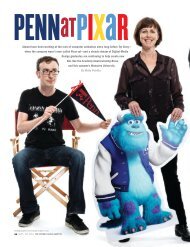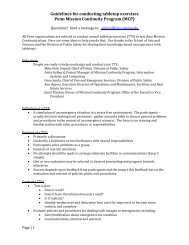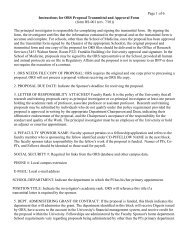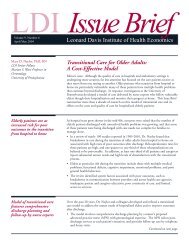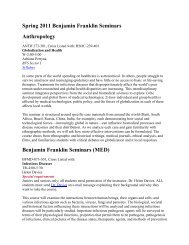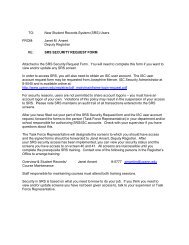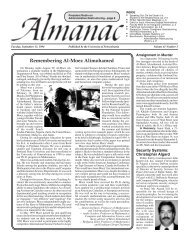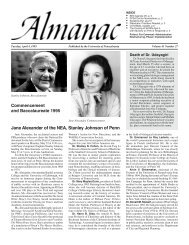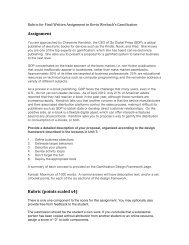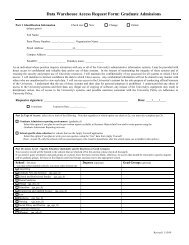PENNPRINTOUT - University of Pennsylvania
PENNPRINTOUT - University of Pennsylvania
PENNPRINTOUT - University of Pennsylvania
You also want an ePaper? Increase the reach of your titles
YUMPU automatically turns print PDFs into web optimized ePapers that Google loves.
large-scale study <strong>of</strong> the financial services industry sponsored<br />
by the Sloan foundation, states that “the beauty <strong>of</strong><br />
the system is that wherever you go, whatever system you<br />
use at the School, the data is accessible and appears in the<br />
identical form.” According to Dr. Herring the key benefit<br />
this provides is that it “reduces the time researchers spend<br />
extracting data and allows them to concentrate on their<br />
analysis.”<br />
The SAS access tools are generally standardized<br />
across different platforms—VMS, HP-UX, Ultrix, DOS,<br />
etc.—giving users the ability to continue their analyses in a<br />
number <strong>of</strong> computing environments. Many other statistical<br />
packages such as SPSS, BMDP, and SPlus can easily<br />
read SAS data sets.<br />
In the future, Wharton Computing and Information<br />
Technology plans to further enhance this data architecture.<br />
In addition to adding more data sets, Wharton plans to<br />
provide transparent data access to an even wider range <strong>of</strong><br />
systems at the School. Wharton is currently testing SAS<br />
for Windows and PC-based NFS client s<strong>of</strong>tware with the<br />
intention <strong>of</strong> mounting data sets onto DOS/Windows<br />
systems at the School, providing access to vast data<br />
resources with the Micros<strong>of</strong>t Windows “look and feel”<br />
familiar to PC users. This will be another step forward in<br />
Wharton’s goal <strong>of</strong> providing information “at the fingertips”<br />
<strong>of</strong> its faculty and students.<br />
KENDALL WHITEHOUSE is an Associate Director for<br />
Wharton Computing and Information Technology; PAUL J.<br />
RATNARAJ is an Information Management Specialist<br />
(responsible for the Wharton Research Data System) for<br />
Wharton Computing and Information Technology.<br />
Teaching with live data<br />
Wharton’s primary objective in developing the<br />
Wharton Research Data System was to assist in faculty<br />
research and student instructional exercises. Because<br />
Wharton’s networked classroom teaching stations<br />
share the same configuration and connectivity as<br />
Wharton’s computing lab stations, this project also<br />
allows faculty to use data sets “live” in the classroom.<br />
This past year students in Michael Phelan’s<br />
Statistics 701 class were taught regression and timeseries<br />
analysis using SAS/ASSIST to manipulate<br />
economic data. “The seamless access to Wharton’s<br />
financial data sets has been a key component <strong>of</strong> my<br />
curriculum development,” reports Dr. Phelan. “It has<br />
influenced my lecture style, which now combines a<br />
formal lecture with a directed recitation.” According<br />
to Dr. Phelan this teaching technique “allows the<br />
students to see the data unfold in real time.”<br />
Frequently students will present suggestions for<br />
new ways to analyze data. Dr. Phelan points out that to<br />
use this technique in the classroom “you need the<br />
flexibility to travel down these new paths, but have the<br />
focus to be sure you cover the essential material.”<br />
The consistent architecture across faculty desktops,<br />
student labs, and classroom teaching stations<br />
provides further advantages for both faculty and<br />
students. “By working with the same s<strong>of</strong>tware<br />
configuration and data sets that students use for their<br />
assignments, I am able to discuss statistical concepts<br />
while demonstrating specific techniques in class that<br />
students can later use in their own work.”<br />
This rich teaching environment hasn’t been<br />
without its difficulties. Using SAS to bring large data<br />
sets into the classroom requires careful coordination <strong>of</strong><br />
a number <strong>of</strong> computing systems at the School. In the<br />
classroom, Dr. Phelan launches an X-session to<br />
connect to a UNIX workstation. The X-server,<br />
Exceed/4, runs under Micros<strong>of</strong>t Windows on one <strong>of</strong><br />
the Novell Netware servers that supports Wharton’s<br />
DOS/Windows computer labs. The UNIX workstation<br />
is an HP 9000/755 that has the Wharton Research<br />
Data System NFS mounted from another HP 9000/<br />
755. To display the X-session to the class requires a<br />
high-resolution projection panel capable <strong>of</strong> projecting<br />
at a resolution <strong>of</strong> 1024 by 768 pixels. In classrooms<br />
without high-resolution RGB three-gun projectors,<br />
Wharton uses an In-Focus PowerView 950 highresolution<br />
LCD panel.<br />
One failure anywhere in the system means Dr.<br />
Phelan must resort to traditional teaching materials.<br />
“I always make certain I can cover the material for<br />
that day’s class using back-up materials if necessary.<br />
Although the system usually works as expected, we’ve<br />
had one or two unanticipated problems that forced me<br />
to abandon ship and take to the blackboard.”<br />
Although Dr. Phelan admits that technological<br />
glitches can be frustrating, he concludes that “I can’t<br />
imagine teaching any other way.” He claims that not<br />
using this technology to teach statistics would be like<br />
“trying to teach someone to ride a bicycle by simply<br />
describing how to do it.”<br />
APRIL 1995 7



